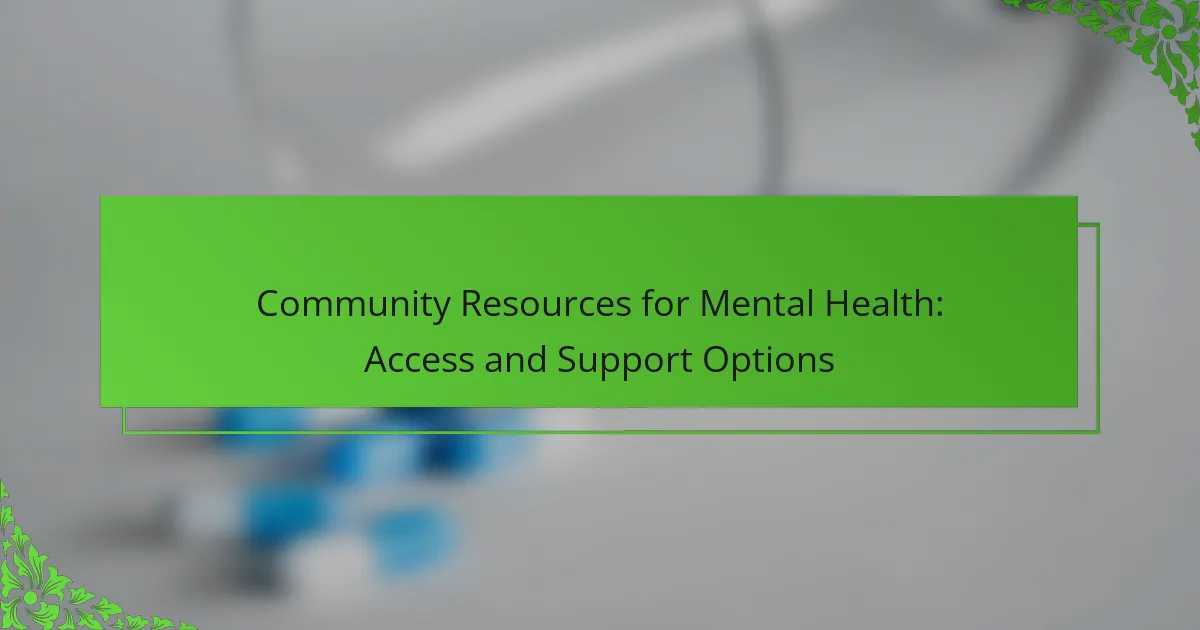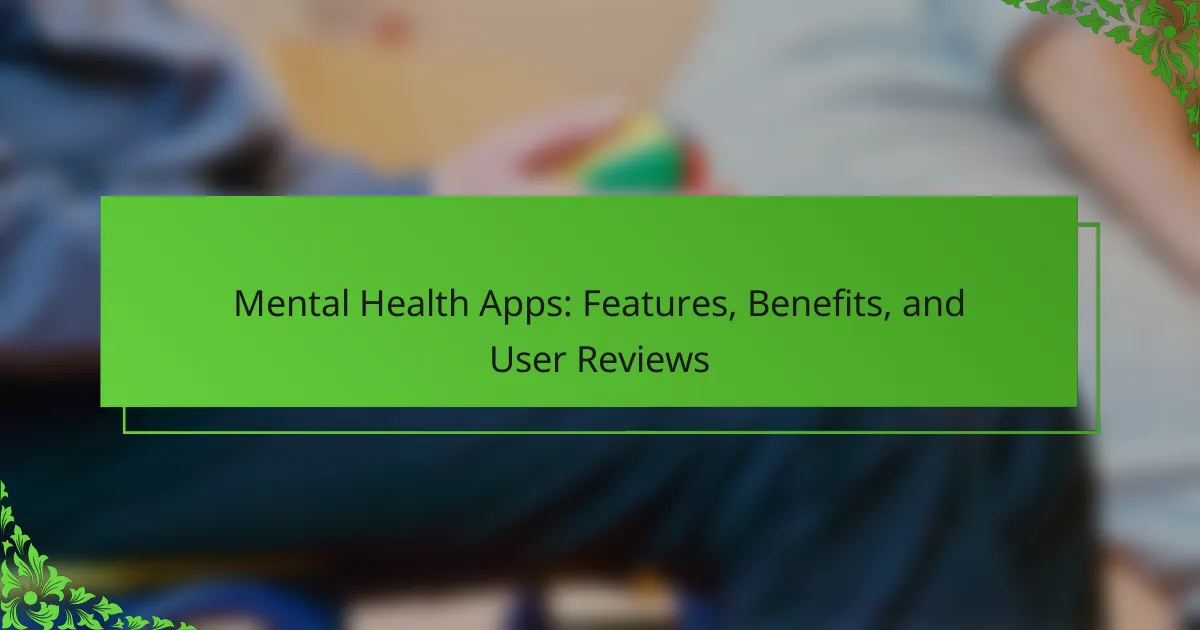Accessing community resources for mental health can significantly enhance well-being and provide crucial support. This article covers various options, including support groups, counseling services, hotlines, and educational programs. It also addresses challenges like funding limitations and stigma, while highlighting innovative practices such as telehealth and peer-led initiatives. Understanding how to effectively utilize these resources is essential for fostering resilience and improving mental health outcomes.

What are the main types of community resources for mental health?
Community resources for mental health include support groups, counseling services, hotlines, community centers, and educational programs. These resources provide access to professional help and peer support, promoting mental well-being.
Support groups offer a platform for individuals to share experiences and coping strategies. Counseling services, often provided by licensed professionals, address specific mental health issues. Hotlines provide immediate assistance and crisis intervention. Community centers frequently host workshops and seminars that educate on mental health topics. Educational programs raise awareness and reduce stigma associated with mental illness.
These resources are vital for fostering a supportive environment, enhancing community resilience, and improving overall mental health outcomes.
How do local mental health organizations provide support?
Local mental health organizations provide essential support through various programs and services. They offer counseling, crisis intervention, and educational resources to individuals and families. These organizations often collaborate with healthcare providers to ensure comprehensive care. Community outreach initiatives raise awareness and reduce stigma around mental health issues. Many organizations also provide specialized services, such as support groups and workshops, tailored to specific populations. Access to these resources enhances community well-being and promotes mental health awareness.
What role do online platforms play in mental health resources?
Online platforms significantly enhance access to mental health resources by providing support options and community engagement. They facilitate connections between individuals and professionals, making mental health services more accessible. For example, teletherapy offers convenience and flexibility, allowing users to seek help from home. Additionally, online forums and support groups foster community, enabling shared experiences and peer support. Research indicates that 75% of users find online resources beneficial for mental health management. These platforms also offer anonymity, which can encourage individuals to seek help without stigma.
Which community programs focus on youth mental health?
Numerous community programs focus on youth mental health, offering vital support and resources. Organizations like the National Alliance on Mental Illness (NAMI) provide education and advocacy. Local initiatives often include counseling services, peer support groups, and crisis intervention programs. Schools frequently partner with mental health organizations to implement wellness programs, ensuring access to mental health resources. Additionally, community centers may host workshops aimed at reducing stigma and promoting mental health awareness.
How do peer support groups contribute to mental health?
Peer support groups significantly enhance mental health by fostering connection and shared experiences. They provide a safe space for individuals to express feelings and challenges, reducing isolation. Participants often gain insights from others facing similar issues, which can lead to improved coping strategies. Research indicates that engagement in these groups can lower anxiety and depression levels, contributing to overall well-being.
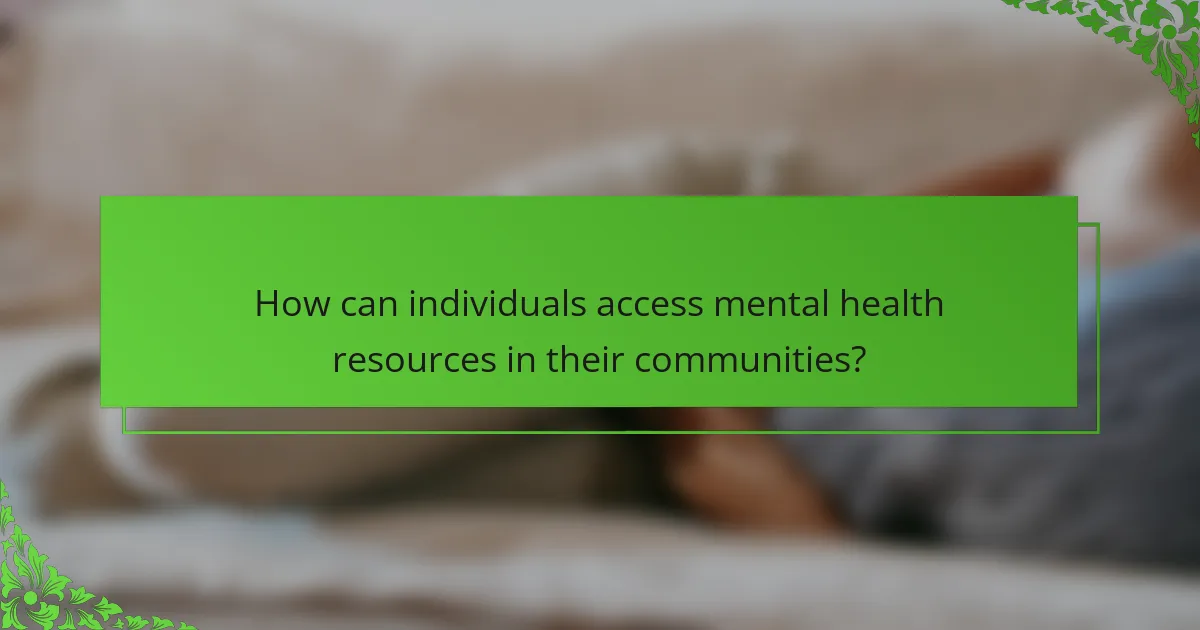
How can individuals access mental health resources in their communities?
Individuals can access mental health resources in their communities through various channels. Local mental health clinics offer counseling and therapy services. Community health centers provide integrated care, including mental health support. Schools often have counselors available for students. Online directories can help locate nearby resources. Support groups and hotlines offer immediate assistance and peer support. Local non-profits frequently organize workshops and outreach programs to raise awareness and provide education.
What are the steps to find local mental health services?
To find local mental health services, start by identifying your needs and preferences. Next, use online directories or community resources to locate available services.
1. Assess your mental health needs.
2. Search online directories like Psychology Today or SAMHSA.
3. Contact local health departments or community centers.
4. Ask for recommendations from healthcare providers or trusted individuals.
5. Verify credentials and services offered.
6. Schedule an appointment to discuss your needs.
How can telehealth services improve access to mental health care?
Telehealth services enhance access to mental health care by providing remote consultations, reducing barriers like transportation and stigma. Patients can connect with licensed professionals from their homes, ensuring timely support. This approach particularly benefits underserved communities, offering convenience and flexibility. Studies show telehealth can lead to increased patient engagement and improved outcomes, making mental health care more accessible and effective.
Which barriers exist in accessing community mental health resources?
Barriers to accessing community mental health resources include stigma, lack of awareness, and limited availability. Stigma surrounding mental health often prevents individuals from seeking help. Many people are unaware of the resources available to them, leading to underutilization. Additionally, community resources may be limited in scope or capacity, resulting in long wait times or insufficient services. Financial constraints further complicate access, as some individuals may not have insurance or the means to pay for care.
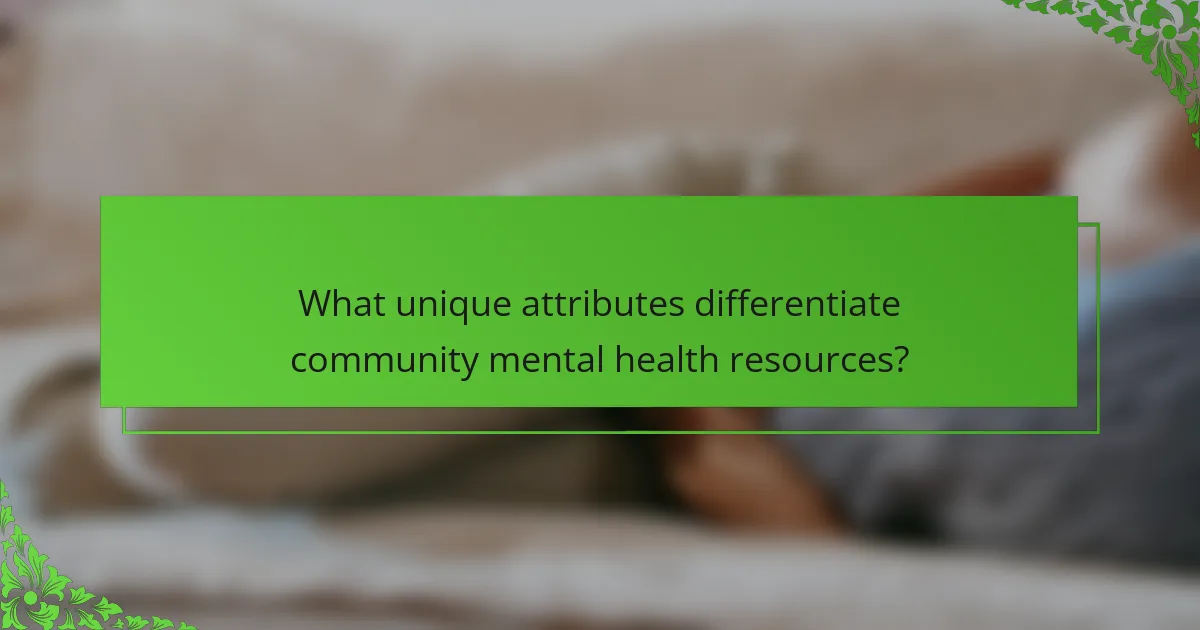
What unique attributes differentiate community mental health resources?
Unique attributes that differentiate community mental health resources include accessibility, cultural competence, and integration with local services. Accessibility ensures that resources are available to diverse populations, including those with mobility challenges. Cultural competence reflects the understanding of various cultural backgrounds, enhancing the effectiveness of support. Integration with local services allows for a holistic approach, addressing interconnected issues such as housing and employment. These attributes contribute to the overall effectiveness and relevance of community mental health resources.
How do cultural factors influence mental health support availability?
Cultural factors significantly impact the availability of mental health support in communities. Variations in beliefs, stigma, and resource allocation shape access to services.
Cultural beliefs influence perceptions of mental health. In some cultures, mental health issues may be viewed as personal weaknesses, leading to stigma. This stigma can deter individuals from seeking help, reducing overall support availability.
Resource allocation is often affected by cultural priorities. Communities may prioritize physical health over mental health, resulting in fewer resources for mental health services. This discrepancy can limit access to necessary support.
Community engagement plays a crucial role in enhancing mental health support. Culturally sensitive programs that respect local traditions can improve acceptance and utilization of mental health resources.
What specialized services are offered for marginalized communities?
Specialized services for marginalized communities include culturally competent therapy, peer support groups, and crisis intervention programs. These resources aim to address unique mental health needs and barriers to access. Culturally competent therapy respects clients’ backgrounds and experiences, enhancing trust and engagement. Peer support groups provide shared experiences and understanding, fostering community connection. Crisis intervention programs offer immediate assistance, reducing the risk of escalation in mental health crises. Access to these services can significantly improve mental health outcomes for marginalized individuals.
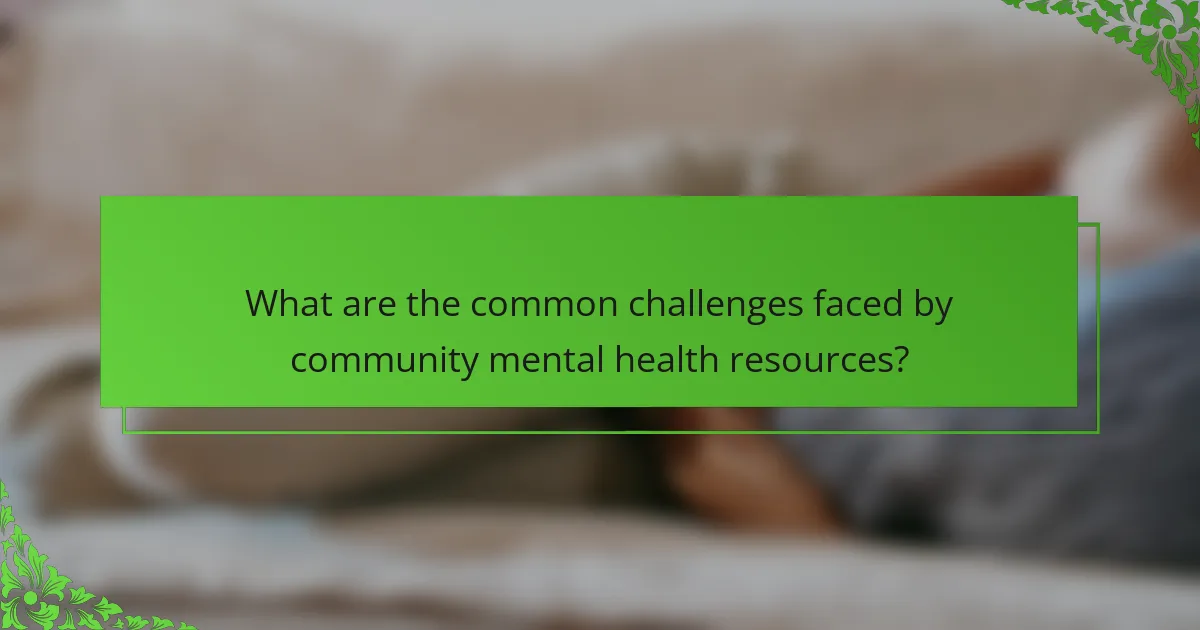
What are the common challenges faced by community mental health resources?
Community mental health resources face several common challenges that hinder their effectiveness. Limited funding restricts service availability and quality. Stigma surrounding mental health issues often discourages individuals from seeking help. Additionally, there is a shortage of trained professionals, leading to long wait times for services. Geographic barriers can limit access for rural populations. Coordination among various service providers is often lacking, which complicates comprehensive care. Finally, the variability in service quality can create disparities in mental health support across communities.
How do funding limitations impact mental health services?
Funding limitations significantly hinder mental health services by restricting access to care and reducing available support options. Limited financial resources often lead to fewer programs, longer wait times, and inadequate staffing. As a result, individuals may struggle to receive timely treatment, exacerbating mental health issues. Inadequate funding can also limit the variety of services offered, which affects diverse community needs. Overall, these limitations create barriers to effective mental health care and support.
What effects do stigma and misinformation have on resource utilization?
Stigma and misinformation significantly reduce the utilization of community mental health resources. Individuals may avoid seeking help due to fear of judgment or misunderstanding of mental health issues. This leads to underutilization of available support options, exacerbating mental health challenges. Misinformation can create barriers by promoting negative perceptions about treatment efficacy or the nature of mental illness. As a result, communities may face increased mental health crises and reduced overall well-being.
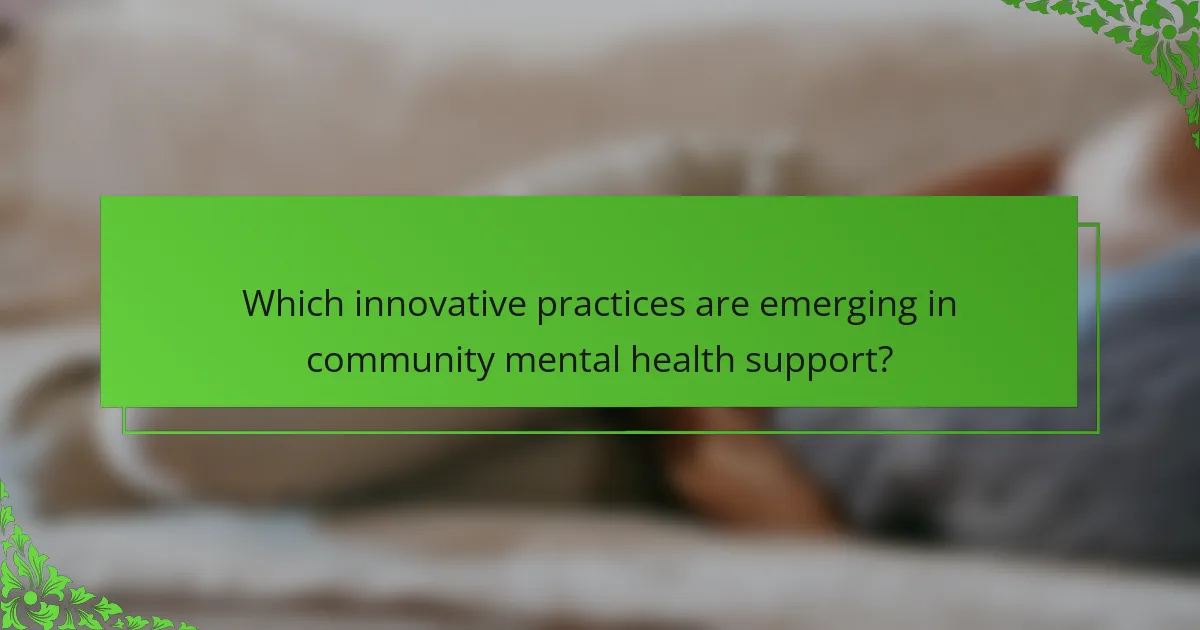
Which innovative practices are emerging in community mental health support?
Innovative practices in community mental health support include peer-led initiatives, telehealth services, and integrated care models. These approaches enhance accessibility and foster community engagement.
Peer-led initiatives empower individuals with lived experience to provide support, reducing stigma and promoting recovery. Telehealth services offer flexible access to mental health professionals, particularly beneficial for underserved populations. Integrated care models combine mental health and primary care, ensuring holistic treatment and improved patient outcomes.
These emerging practices reflect a shift towards more inclusive and accessible mental health support systems.
How are technology and apps transforming mental health access?
Technology and apps are significantly enhancing mental health access by providing immediate support and resources. Digital platforms facilitate connections between individuals and mental health professionals, offering services like teletherapy and self-help tools. These innovations increase accessibility, particularly for those in remote areas or with mobility challenges. Additionally, mental health apps often include features such as mood tracking and guided meditations, promoting proactive mental health management. As a result, technology is not only expanding access but also empowering individuals to take charge of their mental well-being.
What collaborative efforts are being made between organizations?
Organizations are collaborating to enhance community resources for mental health through joint programs and shared initiatives. These partnerships focus on increasing access to mental health services and support options. For instance, local health departments are teaming up with non-profits to provide workshops and training for mental health awareness. Additionally, schools are working with mental health organizations to create support systems for students. Such collaborative efforts aim to build a more robust network of resources, ultimately improving community well-being.
How can community engagement enhance mental health resources?
Community engagement significantly enhances mental health resources by fostering connections and support networks. It cultivates a sense of belonging, which is crucial for mental well-being. Engaged communities can create tailored programs that address specific mental health needs, ensuring accessibility and relevance. Collaborative efforts between local organizations and residents lead to increased awareness of available resources, reducing stigma associated with seeking help. Research shows that communities with active mental health initiatives report lower rates of anxiety and depression, demonstrating the positive impact of collective action on mental health outcomes.
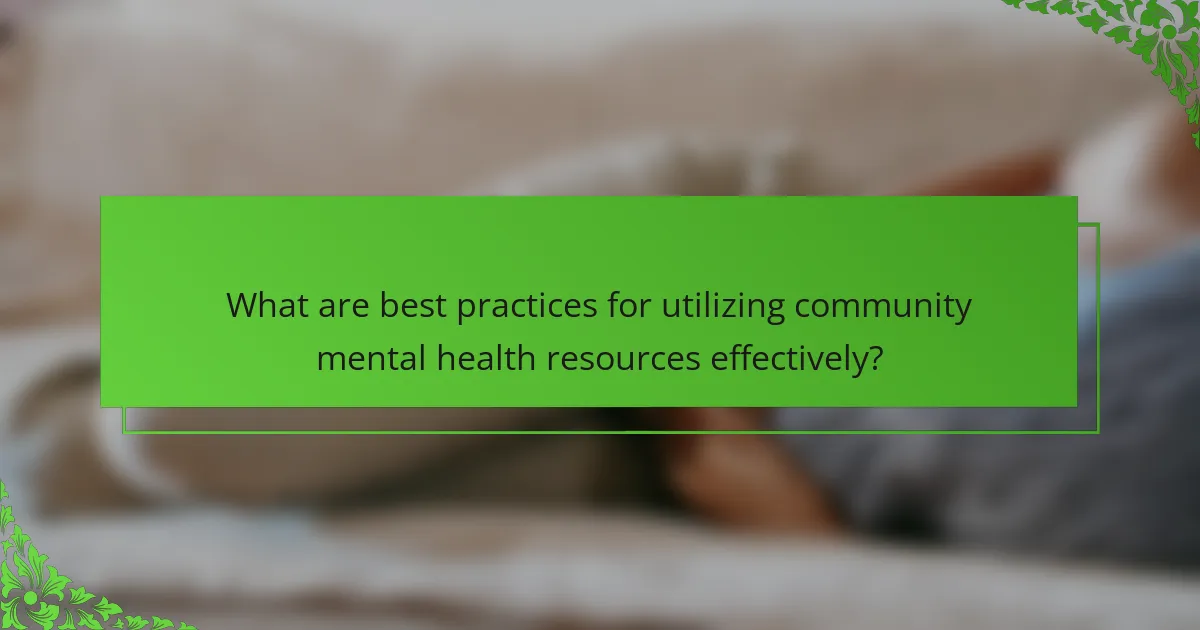
What are best practices for utilizing community mental health resources effectively?
To utilize community mental health resources effectively, engage with local services, seek support groups, and connect with trained professionals. Identify available resources through community centers, hotlines, or online directories. Establish a support network that includes family and friends. Regularly assess your needs and adjust your resource use accordingly. Prioritize accessibility and consider virtual options if in-person visits are challenging.
How can individuals advocate for better mental health services in their communities?
Individuals can advocate for better mental health services by engaging with local organizations and policymakers. They can raise awareness about mental health issues through community events and social media campaigns. Collaborating with healthcare providers to identify gaps in services is crucial. Additionally, forming support groups can empower individuals to share experiences and advocate collectively. Building partnerships with schools and workplaces can promote mental health education and resource accessibility. Engaging in public forums allows individuals to voice concerns and propose solutions directly to decision-makers.
What strategies can enhance participation in mental health programs?
Engaging community members through targeted outreach and tailored programming enhances participation in mental health programs. Strategies include building partnerships with local organizations, offering flexible scheduling, and utilizing peer support networks. Providing culturally relevant resources and promoting awareness through social media can also increase engagement. Regular feedback from participants helps refine offerings and meet community needs effectively.
